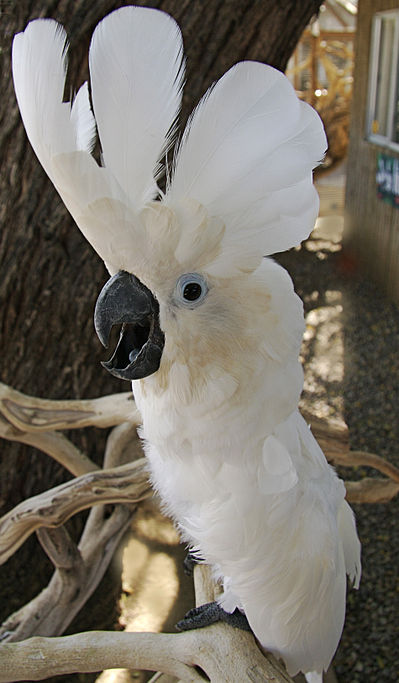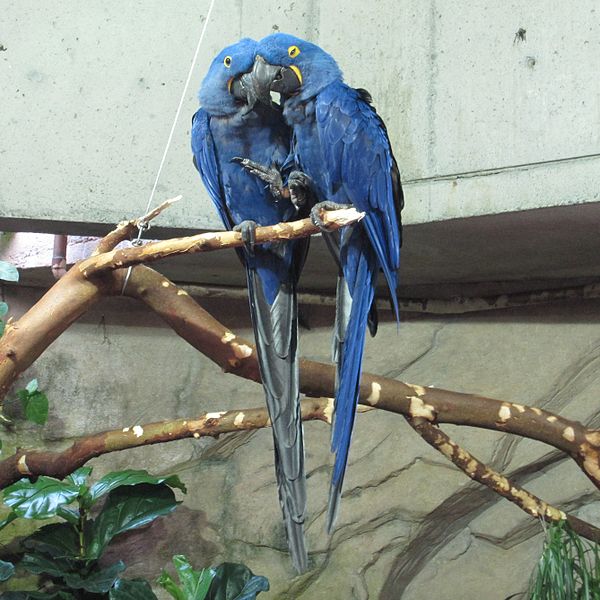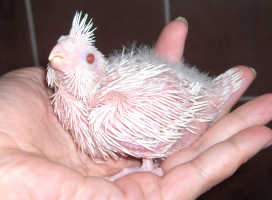 Like most old zookeepers, I have a soft spot for old animals. I’ve been fortunate in having had the chance to care for a number of birds that survived to record longevities – a Pell’s Fishing Owl and Smoky Eagle Owl of 50+ years, a tiny Egyptian Plover that lived into its 20’s, and any number of Parrots. But it is a “50-something”-year-old Marabou Stork (Leptoptilos crumeniferus), known to his Bronx Zoo caretakers as “Jake”, who stands out most vividly in my mind. Read More »
Like most old zookeepers, I have a soft spot for old animals. I’ve been fortunate in having had the chance to care for a number of birds that survived to record longevities – a Pell’s Fishing Owl and Smoky Eagle Owl of 50+ years, a tiny Egyptian Plover that lived into its 20’s, and any number of Parrots. But it is a “50-something”-year-old Marabou Stork (Leptoptilos crumeniferus), known to his Bronx Zoo caretakers as “Jake”, who stands out most vividly in my mind. Read More »
Tag Archives: Bird Behavior
Feed SubscriptionParrot Body Language – Puffed Feathers
Parrots use a wide range of postures when communicating with one another and with their owners. Understanding the meaning of your parrot’s body language will simplify interactions with your pet, and is also important in assessing its health. Today we’ll look at puffed feathers – a behavior which can have several very different meanings, and so must be judged in the context of the surrounding circumstances.
Temperature
Parrots, and all birds for that matter, puff up their feathers in an effort to keep warm. The layer of air trapped within the feathers and warmed by the parrot’s body provides amazingly effective insulation. If you watch native birds during cold weather, you can readily observe this behavior. A bird’s internal temperature is much higher than our own, averaging 106-110 F, and so many species (but only a few parrots!) easily tolerate frigid weather.
Puffed feathers can, oddly enough, also indicate that your parrot is too warm. In this case, the feathers may be flared to a greater degree than when cold temperatures are involved, and the wings may be held out a bit from the body. When very hot, the parrot may open its beak and pump the throat rapidly, a behavior known as gular flapping.
Aggression
 Like many animals, parrots that feel threatened will attempt to make themselves appear larger…flaring their feathers and sometimes spreading the wings. The head feathers may be raised quite high, even among species without crests (the “head display kings” are the cockatoos and hawk headed parrots; please see photo). Aggressive parrots will also stare at the threat – you may notice the eye’s pupil widening as well – and may snap their beaks or scream.
Like many animals, parrots that feel threatened will attempt to make themselves appear larger…flaring their feathers and sometimes spreading the wings. The head feathers may be raised quite high, even among species without crests (the “head display kings” are the cockatoos and hawk headed parrots; please see photo). Aggressive parrots will also stare at the threat – you may notice the eye’s pupil widening as well – and may snap their beaks or scream.
A normally friendly bird that suddenly begins exhibiting this behavior, especially if it does so as you approach, may be masking an injury. Anticipating pain, the bird is warning you off and so should be checked carefully. Sudden aggression may also arise as a result of hormonal changes associated with sexual maturity, or because the bird is jealous of attention being given its favorite person by another pet or individual.
Sickness
Sick or injured parrots, and females having difficulty passing eggs, will sit, sometimes on the cage floor, with their feathers puffed out and the body held in a “hunched” position. The eyes may be closed or partially closed as well. As it is in a bird’s “best interests” to hide any symptoms of illness (predators single out sick and injured individuals as prey), parrots exhibiting such dramatic signs of illness should be seen by a veterinarian right away.
Further Reading
Parrot sounds also convey a great deal of information; to learn more, please see my article What is My Parrot Saying?
Umbrella Cockatoo image referenced from wikipedia and originally posted by Benjamin Graves
Bird Reproduction – How Natural Social Behaviors Affect Captive Breeding
Bird breeding is rarely as simple as putting a male and female together and hoping for the best. Even Budgerigars and others that been captive bred for thousands of generations remain influenced by ancestral behaviors. Understanding this will greatly improve our success at keeping and breeding birds in captivity.
Social Behavior in General
 The majority of pet trade birds are highly social creatures. Although they may squabble during the breeding season, the presence of flock-mates is a strong breeding stimulus. Indeed, many aviculturists cite the absence of additional individuals as the main reason for breeding failures among well-bonded pairs.
The majority of pet trade birds are highly social creatures. Although they may squabble during the breeding season, the presence of flock-mates is a strong breeding stimulus. Indeed, many aviculturists cite the absence of additional individuals as the main reason for breeding failures among well-bonded pairs.
Even reliable captive breeders such as Budgerigars may not reproduce if held in single pairs. The addition of another pair, or even housing the pair within sight or hearing of others of their kind, often spurs nesting.
Aggression (Adults)
Despite the fact that group situations may encourage breeding, we must also bear in mind that birds living together form themselves into cohesive flocks. Newly introduced individuals, even those suitable as mates for unpaired birds in the flock, may be attacked, especially during the breeding season.
Oddly enough, larger flocks are often more peaceful than small groups (a rule that I’ve found applicable to creatures ranging from fishes to baboons!). Aggression tends to be meted out among several as opposed to 1 individual, and non-target birds often “get involved” and divert aggressors’ attentions.
Aggression (Chicks)
In most cases, youngsters should be removed from their parent’s cage once they are feeding on their own. Otherwise, they may interfere with the rearing of later broods, or may be attacked by the male (monk parrots and other colonial nesting species are often exceptions).
Usually, smaller, short-lived species (lovebirds, parrotlets), and those that inhabit harsh environments (grass parakeets) are likely to attack newly-fledged youngsters Such birds are evolutionarily adapted to reproduce often, or to be ready as soon as the unpredictable rains arrive, and so are usually eager to re-nest. However, despite being opportunistic breeders, budgerigars and cockatiels are often tolerant of fledglings.
Macaws and Other Long-Lived Birds
 Large, long-lived parrots usually raise only a few chicks each season, and may not breed every year. Unlike the species described above, most inhabit environments that offer predictable weather patterns and food sources, and so they can “afford” to spend a great deal of time in imparting survival skills to their young. Macaws, African Gray Parrots and similar species are, therefore, usually quite tolerant of their youngsters long after they have left the nest.
Large, long-lived parrots usually raise only a few chicks each season, and may not breed every year. Unlike the species described above, most inhabit environments that offer predictable weather patterns and food sources, and so they can “afford” to spend a great deal of time in imparting survival skills to their young. Macaws, African Gray Parrots and similar species are, therefore, usually quite tolerant of their youngsters long after they have left the nest.
Mate Choice
Birds can be quite choosy (maddeningly so!) when it comes to mate selection. This is especially true for macaws, Amazons, African Grays and other long-lived parrots. Their pair bonds span many decades, so it behooves them to “get it right” the first time (I’ll avoid here the obvious parallels one could draw regarding our own species!). If you are intent on breeding, it would be prudent to purchase a bonded pair or individuals that mutually groom and spend time near each other.
Some species deviate from the usual “parrot pair model”. Certain Australian Parakeets, for example, have “difficult” relationships outside of the breeding season…they remain as a pair, but the females become somewhat aggressive towards the males. In the close confines of captivity, they can make life quite miserable for their unfortunate mates. As always, research your pet’s natural history thoroughly.
Further Reading
To read about what behaviors to expect as spring returns, please see Spring’s Effect of Parrots and Other Birds.
Hyacinth Macaw image referenced from wikipedia and originally posted by Snowmanradio
Macaws, Amazons and Conures in Ecuador image referenced from wikipedia and originally posted by Hjallig
Bird Breeding – Why Do Good Parents Sometimes Attack Their Chicks?
Parrots that pair up well, mate, hatch eggs and feed their chicks are every bird-breeders dream. However, some such birds present us with a frustrating situation – just as the chicks begin to grow feathers, one or both of the otherwise doting parents begin to pluck at their chicks’ feathers. Bleeding and skin bruising follow, and, while the chicks usually recover, they are often left high-strung and nervous. Chicks housed in outdoor aviaries may suffer from exposure and chilling as well.
The Scenario

Chick-plucking is most commonly observed among peach-faced lovebirds, budgerigars and cockatiels (particularly lutino cockatiels). Attacks on the plumage usually commence when the feathers first emerge from the skin, and may continue until the time they unfurl. Oddly, the erring adults continue to feed their offspring throughout, and remain good parents once the plucking ceases.
Unfortunately, chick-plucking parents usually do not change, and subsequent offspring are usually attacked as well; there is also evidence that chicks born to “plucking parents” repeat the cycle when they mature and reproduce.
A Theory
The most likely explanation for this perplexing behavior is that it results from frustrated attempts by the parents to preen the emerging feathers. Unable to perform this task properly on the thin, unfurled plumage, the anxious parents begin pulling at the feathers. The fact that most attacks are confined to the chicks’ napes and upper wings – areas not reachable by the chicks and usually attended to by the parents, lends support to this theory.
Thwarting Attacks
 Bitter Apple Spray is often successful in deterring plumage attacks, but is best applied before plucking begins. If the chick’s skin is broken, consult your veterinarian before applying Bitter Apple or similar products.
Bitter Apple Spray is often successful in deterring plumage attacks, but is best applied before plucking begins. If the chick’s skin is broken, consult your veterinarian before applying Bitter Apple or similar products.
Further Reading
Captive breeding, while immensely rewarding, is not without its problems. To read about other potential concerns, please see my article Spring’s Affect on Cage Birds.
Lovebird with newborn chicks image referenced from wikipedia and originally posted by Snowmanradio
Whitefaced lutino Cockatiel Chick image referenced from wikipedia and originally posted by Magnus Manske
 That Bird Blog – Bird Care and History for Pet Birds
That Bird Blog – Bird Care and History for Pet Birds
